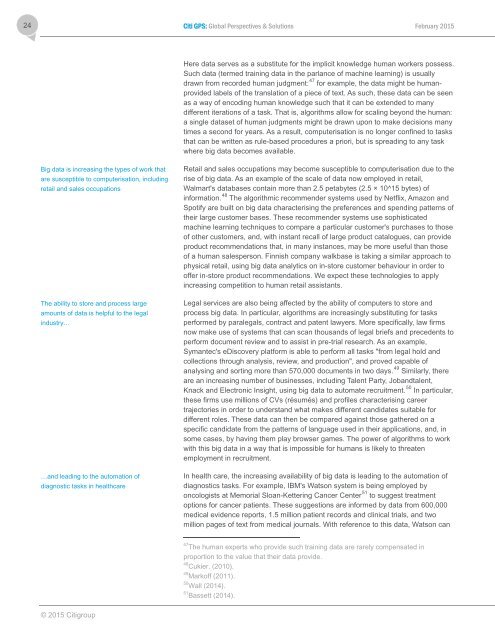TECHNOLOGY AT WORK
1Oclobi
1Oclobi
You also want an ePaper? Increase the reach of your titles
YUMPU automatically turns print PDFs into web optimized ePapers that Google loves.
24<br />
Citi GPS: Global Perspectives & Solutions February 2015<br />
Here data serves as a substitute for the implicit knowledge human workers possess.<br />
Such data (termed training data in the parlance of machine learning) is usually<br />
drawn from recorded human judgment: 47 for example, the data might be humanprovided<br />
labels of the translation of a piece of text. As such, these data can be seen<br />
as a way of encoding human knowledge such that it can be extended to many<br />
different iterations of a task. That is, algorithms allow for scaling beyond the human:<br />
a single dataset of human judgments might be drawn upon to make decisions many<br />
times a second for years. As a result, computerisation is no longer confined to tasks<br />
that can be written as rule-based procedures a priori, but is spreading to any task<br />
where big data becomes available.<br />
Big data is increasing the types of work that<br />
are susceptible to computerisation, including<br />
retail and sales occupations<br />
The ability to store and process large<br />
amounts of data is helpful to the legal<br />
industry…<br />
…and leading to the automation of<br />
diagnostic tasks in healthcare<br />
Retail and sales occupations may become susceptible to computerisation due to the<br />
rise of big data. As an example of the scale of data now employed in retail,<br />
Walmart's databases contain more than 2.5 petabytes (2.5 × 10^15 bytes) of<br />
information. 48 The algorithmic recommender systems used by Netflix, Amazon and<br />
Spotify are built on big data characterising the preferences and spending patterns of<br />
their large customer bases. These recommender systems use sophisticated<br />
machine learning techniques to compare a particular customer's purchases to those<br />
of other customers, and, with instant recall of large product catalogues, can provide<br />
product recommendations that, in many instances, may be more useful than those<br />
of a human salesperson. Finnish company walkbase is taking a similar approach to<br />
physical retail, using big data analytics on in-store customer behaviour in order to<br />
offer in-store product recommendations. We expect these technologies to apply<br />
increasing competition to human retail assistants.<br />
Legal services are also being affected by the ability of computers to store and<br />
process big data. In particular, algorithms are increasingly substituting for tasks<br />
performed by paralegals, contract and patent lawyers. More specifically, law firms<br />
now make use of systems that can scan thousands of legal briefs and precedents to<br />
perform document review and to assist in pre-trial research. As an example,<br />
Symantec's eDiscovery platform is able to perform all tasks "from legal hold and<br />
collections through analysis, review, and production", and proved capable of<br />
analysing and sorting more than 570,000 documents in two days. 49 Similarly, there<br />
are an increasing number of businesses, including Talent Party, Jobandtalent,<br />
Knack and Electronic Insight, using big data to automate recruitment. 50 In particular,<br />
these firms use millions of CVs (résumés) and profiles characterising career<br />
trajectories in order to understand what makes different candidates suitable for<br />
different roles. These data can then be compared against those gathered on a<br />
specific candidate from the patterns of language used in their applications, and, in<br />
some cases, by having them play browser games. The power of algorithms to work<br />
with this big data in a way that is impossible for humans is likely to threaten<br />
employment in recruitment.<br />
In health care, the increasing availability of big data is leading to the automation of<br />
diagnostics tasks. For example, IBM's Watson system is being employed by<br />
oncologists at Memorial Sloan-Kettering Cancer Center 51 to suggest treatment<br />
options for cancer patients. These suggestions are informed by data from 600,000<br />
medical evidence reports, 1.5 million patient records and clinical trials, and two<br />
million pages of text from medical journals. With reference to this data, Watson can<br />
47 The human experts who provide such training data are rarely compensated in<br />
proportion to the value that their data provide.<br />
48 Cukier. (2010).<br />
49 Markoff (2011).<br />
50 Wall (2014).<br />
51 Bassett (2014).<br />
© 2015 Citigroup










